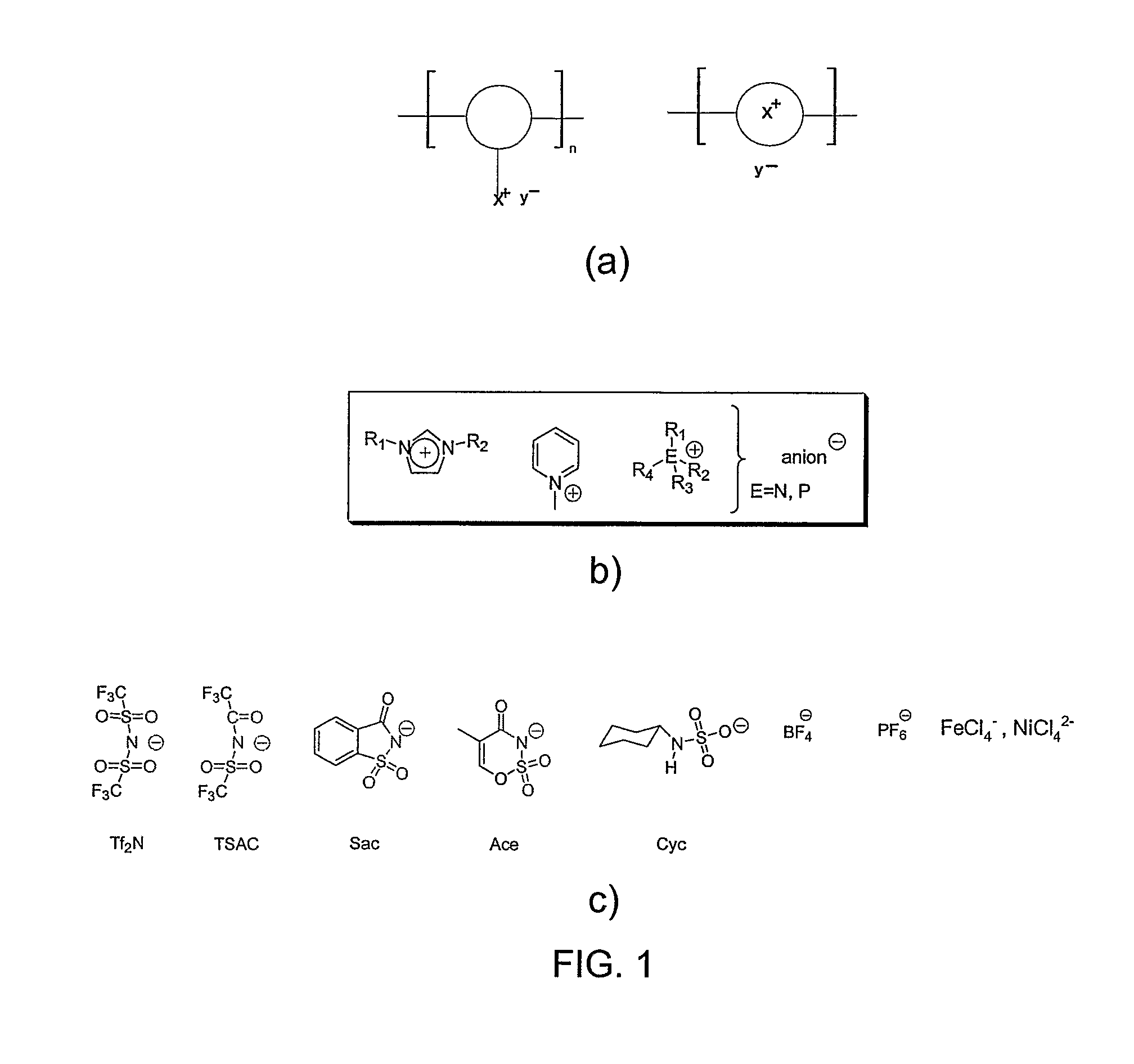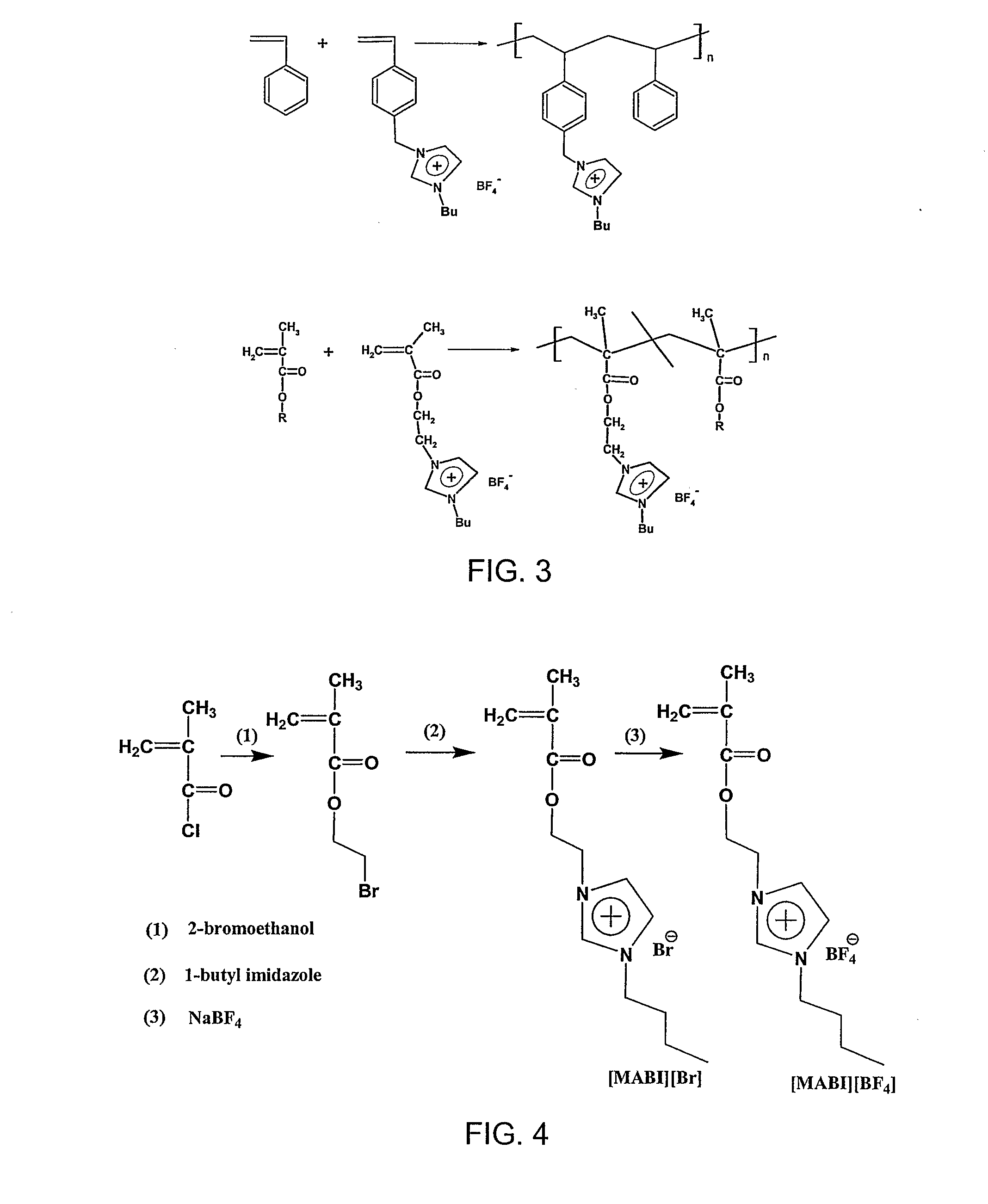Polymers and Copolymers of Ionic Liquids as Radio Frequency Absorbing Materials
a technology of ionic liquid and copolymer, which is applied in the field of ionic polymers and copolymers made from ionic liquid, can solve the problems that no conventional polymer has been found to have strong microwave absorption properties, and achieve the effect of high radiation absorption and radiation absorption characteristics
- Summary
- Abstract
- Description
- Claims
- Application Information
AI Technical Summary
Benefits of technology
Problems solved by technology
Method used
Image
Examples
example 1
Materials
[0026]4-Vinylbenzyl chloride, methacryloyl chloride, 1-butylimidazole, 2-bromoethanol, lithium trifluoromethane sulfonimide, potassium hexafluorophosphate, sodium tetrafluoroborate, 2,6-di-tert-butyl-4-methyl phenol (DBMP), 2,2′-azobisisobutyronitrile (AIBN), aluminum isopropoxide, epichlorohydrin, N,N-dimethylformamide (DMF), acetonitrile, and acetone were purchased from Aldrich. 1-Methylimidazole, and o-benzoic sulphimide sodium salt hydrate were purchased from Lancaster Synthesis Inc. These chemicals were used without further purification.
Synthesis and Characterization
[0027]1-[2-(Methylacryloyloxy)ethyl]-3-butyl-imidazolium tetrafluoroborate ([MABI][BF4]) and 1-(p-vinylbenzyl)-3-butyl-imidazolium tetrafluoroborate ([VBBI][BF4]) were synthesized according to our published reports [Ding, S.; Tang, H. Radosz, M.; Shen, Y. J Polym Sci Part A: Poly Chem 2004, 42, 5794-5801; Tang, H.; Tang, J.; Radosz, M.; Shen, Y. J Polym Sci Part A: Poly Chem 2005, 43, 1432-1443], as shown i...
example 2
Materials
[0047]4-vinylbenzyl chloride (90%), 1-methylimidazole (98%), lithium trifluoromethane sulfonimide 99.95%, potassium hexafluorophosphate 98%, sodium tetrafluoroborate (98%), 2,6-Di-tert-butyl-4-methyl phenol (98%) (DBMP), N,N-Dimethylformamide (99.8%) (DMF), acetonitrile (99.5+%), acetone (99.5+%), aqueous [2-(methacryloyloxy)ethyl]trimethyl ammonium chloride solution (75 wt. %), (p-vinylbenzyl)trimethylammonium chloride (98%), triethylamine (99.5%), tributylamine (99.5%) triphenylphosphine 99%, α,α′-azobis(isobutyrobitrile)(AIBN) (98%) were purchased from Aldrich. 1-methyl imidazole 99%, o-Benzoic sulphimide sodium salt hydrate (97%) were purchased from Lancaster Synthesis Inc. Pyridine was purchased from Fisher scientific. All chemicals were used as received.
Synthesis and Characterization
[0048](p-vinylbenzyl)trimethyl ammonium tetrafluoroborate ([VBTMA][BF4]) and 2-(methacryloyloxy)ethyltrimethylamnonium tetrafluoroborate ([MATMA][BF4]) were synthesized as described previo...
example 3
Materials
[0055]Bis(2-hydroxyethyl)dimethyl ammonium chloride (Acros, 99%), 2,2-Bis(bromomethyl)-1,3-propanediol (Aldrich, 98%), 1-Methylimidazole (Lancaster, 99%), 1-Butylimidazole (Aldrich, 98%), 1,1-Carbonyldiimidazole (Aldrich, reagent grade), terephthaloyl chloride (Aldrich, 99+%), sodium tetrafluoroborate (Aldrich, 98%, NaBF4), dimethyl sulfoxide (Aldrich, 99.9+%, DMSO) and methanol (A.C.S. reagent) were used as received. Acetonitrile (Aldrich, 99.5+%), N,N-Dimethylformamide (Aldrich, 99.8%, DMF) and triethylamine (EMD, 99.5%, Et3N) were used after removing water by molecular sieves.
Synthesis and Characterization
[0056]The synthesis of the monomers, Bis(2-hydroxyethyl)dimethyl ammonium tetrafluoroborate ([BHEDMA][BF4]) 1, 2,2-Bis(methylimidazolium methyl)-1,3-propanediol tetrafluoroborate ([BMIMP][BF4]) 2 and 2,2-Bis(butylimidazolium methyl)-1,3-propanediol tetrafluoroborate ([BBIMP][BF4]) 3 are shown in FIG. 7. The reagents and conditions were: a) NaBF4, acetonitrile, room temp...
PUM
| Property | Measurement | Unit |
|---|---|---|
| melting point | aaaaa | aaaaa |
| frequency | aaaaa | aaaaa |
| frequency | aaaaa | aaaaa |
Abstract
Description
Claims
Application Information
 Login to View More
Login to View More - R&D
- Intellectual Property
- Life Sciences
- Materials
- Tech Scout
- Unparalleled Data Quality
- Higher Quality Content
- 60% Fewer Hallucinations
Browse by: Latest US Patents, China's latest patents, Technical Efficacy Thesaurus, Application Domain, Technology Topic, Popular Technical Reports.
© 2025 PatSnap. All rights reserved.Legal|Privacy policy|Modern Slavery Act Transparency Statement|Sitemap|About US| Contact US: help@patsnap.com



